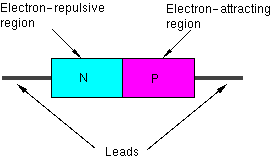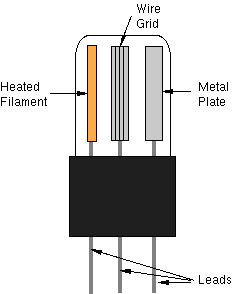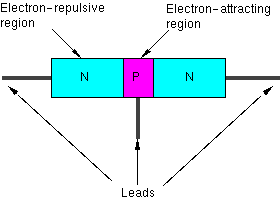Electric Valves: Diodes, Triodes, and Transistors
An important class of electric circuit components act as valves to the flow of current, causing the current to flow in only one direction, or turning the current on and off. Some of these are diodes, triodes, and transistors.
In Britain, these components are actually referred to as “valves”. In North America, they aren’t, but they should be.
In radios and TV’s made before the 1960s, all valves were vacuum tubes. A vacuum tube is so named because air has been evacuated from it. The primary reason for the vacuum is that electrons move much more freely through a vacuum than through air.
Nowadays, vacuum tubes aren’t used so much because much smaller and more efficient solid-state components are available. But most TV sets still contain one big vacuum tube: the TV tube itself.
I’m including a discussion of vacuum-tube valves because I find their operation easy to visualize. They can serve as a stepup to understanding solid-state valves.
The modern solid-state valves are made with special solid materials, called semiconductors. Semiconductors conduct electricity to a degree—not as well as metals, but better than materials that are used as insulators. Also, they can be fabricated in such a way that they either attract or repulse electrons. It is this property that makes the valves work.
Diodes
A diode is an electric component that allows electric current to flow in only one direction.
Vacuum-tube diodes
A vacuum-tube diode contains two main parts (that’s the “di” in “diode”). One part is a heated filament, the other is a metal plate.
(Note that I’ve left off some details for clarity. In practice, there are more leads to supply power for heating the filament.)
A voltage applied across the leads to the tube will make any free electrons in the tube move in the direction of the voltage. But without any other encouragement, most electrons will remain attached to the metal on which they rest.
The heating of the filament tends to loosen some of its electrons.
If a voltage is applied to give the filament a negative charge and the plate a positive charge, these loosened electrons will fly from the filament to the plate. Current flows through the tube.
On the other hand, if the applied voltage gives the filament a positive charge and the plate a negative charge, the loosened electrons on the filament will have no incentive to go to the plate, and the electrons on the plate aren’t loose enough to leave it. No current flows through the tube.
Solid-state diodes
A solid-state diode is made of a single piece of semiconducting material with two regions: one region attracts electrons, the other repulses them. I’ll label the one that attracts electrons with a P and the one that repulses electrons with an N, because they act as if they were positively and negatively charged, respectively.

At the junction between the two regions, electrons are much more likely to move from the N side to the P side.
If a voltage is applied to make electrons flow from the N side to the P side, the electrons will have no trouble crossing the junction and so current will flow through the diode.
On the other hand, if a voltage is applied to make electrons flow from the P side to the N side, the electrons will have trouble crossing the junction and so very little current will flow through the diode.
Triodes and Transistors
The vacuum tube called a triode and the solid-state device called a transistor are components that can amplify a signal in an electric current. They can also serve as an electronic switch, that is either on or off.
Triode tubes
A triode is much like the diode vacuum tube, except that it has an additional part: a metal wire grid, between the heated filament and plate.

(Once again, several details have been omitted for clarity. In practice, some more electronics is required to keep the grid at approximately the same potential as the filament.)
In operation, a large voltage is applied across the filament and plate leads to make the filament negatively charged, and the plate positively charged.
The flow of electrons from the filament to the plate is attenuated by the electrical charge on the grid between them. When the charge on the grid is negative, the electrons are repelled by it and so they don’t tend to fly toward the plate. When the charge on the grid is positive, they fly right through it on to the plate.
The effect is that a small electrical signal fed into the grid is greatly amplified in the current flowing through the triode. The triode is the means by which a little radio signal is amplified into a big electric current in old radios. The small radio signal coming from the antenna is fed into the grid, and it greatly alters the voltage flowing through the triode.
Another use of the triode is as a switch: So long as a small charge is kept on the grid, no current flows through the tube. The switch is “off”. If the small charge is removed from the grid, current flows through the tube. The switch is then “on”.
Transistors
The function of the solid-state transistor is much like that of the triode vacuum tube, with a small signal attenuating a large current, except that the transistor doesn’t act as a diode—current is equally free to move in either direction through it.
It consists of a single piece of semiconductor material with three regions, two made to be repulsive to electrons (labelled N in the diagram) and one region between the others made to be attractive to electrons (labelled P).
Conductive leads are attached to the two N regions, and a third lead is attached to the P region.

In operation, a voltage is applied across the leads attached to the N regions.
The P region plays the same role as the metal grid does in the triode tube. If a small voltage is applied to it to make the P negatively-charged, electrons are not as likely to cross from one N regions to the other. If the voltage is removed, electrons flow much more freely from one N regions to the other.
Just as with the triode tube, the transistor is used in radios as a signal amplifier.
Most of the transistors in the world now reside as microscopic components of computer chips. There they play the role of switches, storing the zeros and ones that are the basis for the computer’s logic.